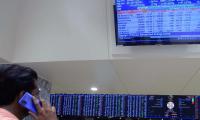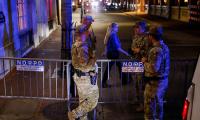London: The dollar will maintain its position as the world’s dominant reserve currency over the next decade, confounding growing calls from some countries for the adoption of alternatives, according to a closely watched annual survey of central banks.
Research by the Official Monetary and Financial Institutions Forum (OMFIF), a UK central banking think-tank, found that reserve banks managing close to a combined $5 trillion of assets expect the dollar to continue to decline as a proportion of global reserves at a “gradual” pace. However, it will still account for 54 percent of the total in 10 years’ time, compared with 58 percent currently, the survey found. Reserve currencies are foreign assets held in large quantities by central banks for international payments and to support local currencies.
Among those trying to challenge the dollar’s hegemony is Brazil’s president Luiz Inácio Lula da Silva, who called for emerging markets to review their reliance on the greenback at a summit in Paris last week. South Africa’s president Cyril Ramaphosa said “the issue of currency” would be “on the agenda” for the upcoming meeting of Brics countries in August, which also includes Russia, India and China.
The dominance of the dollar has gradually declined in recent decades as the role of the US in global trade has waned, while the freezing of over $300 billion worth of Russian central bank assets last year sparked fresh calls among some of the world’s largest emerging economies to shift away from the US currency. At the turn of the century the dollar accounted for more than 70 percent of global reserves, according to IMF data.
“The sense of de-dollarisation is in line with the historic trend over the last ten years,” said Nikhil Sanghani, managing director at OMFIF. “Reserve managers are telling us there’s unlikely to be a major trend from that path.”
The OMFIF survey found that 16 percent of reserve banks planned to increase US dollar exposure in the next couple of years, compared with 10 percent that planned to reduce it.
However, over the next 10 years, a net 6 percent of reserve banks said they expected to reduce their dollar holdings.
China, the world’s largest reserve asset holder, has been pushing for greater adoption of its currency by other countries. But Sanghani said the sanctions on Russia had brought the issue of geopolitics into “sharper focus” and some reserve managers “will be looking at US tensions with China and be reluctant to invest in China right now”. The study found just 13 percent of respondents said they expected to increase holdings in China’s currency, down from more than 30 percent last year.
However, on a 10-year horizon, two-fifths of central banks expected to add to their renminbi holdings, forecasting that its share of global reserves would grow from about 3 percent to 6 percent by 2033.
“Reserve managers are saying that in 10 years we want to move in that direction but now is not the time to do it,” Sanghani said. OMFIF’s study found that the euro was likely to be the biggest beneficiary of the trend away from the dollar and cooling sentiment on China.
The euro currently accounts for about 23 percent of global reserves, but a net 14 percent of central banks said they planned to increase their euro holdings over the next two years. That was ahead of demand for any other currency, and marked a big increase from last year when no banks had considered boosting euro reserves. Meanwhile, the survey also found that not one of the 75 central banks expected inflation to return to 2 percent in the next 12 to 24 months.
“Reserve managers have little confidence that their colleagues on monetary policy committees will get inflation under control,” the report said. Just over half of the central banks expected inflation to remain stuck between 2 percent and 4 percent, while 48 percent thought inflation would be between 4 percent and 6 percent.
A representational image of gold jewellery. — AFP/FileKARACHI: Gold prices rose by Rs1,000 per tola on Wednesday in...
Nigerian President Bola Tinubu looks on as he meets with South African President Cyril Ramaphosa on the day of the...
The Wall Street entrance to the New York Stock Exchange is seen in New York City, US, November 15, 2022. —...
A representational image showing people walking past a market area. — AFP/FileLAHORE: Proponents of the current...
Power and communication lines are seen on a dark street in San Juan, Puerto Rico after a major power outage hit the...
Temu logo is seen in this illustration taken November 4, 2024. — ReutersMEXICO CITY: Mexico’s tax authority SAT...







